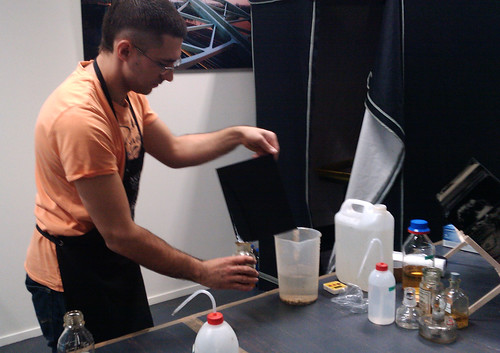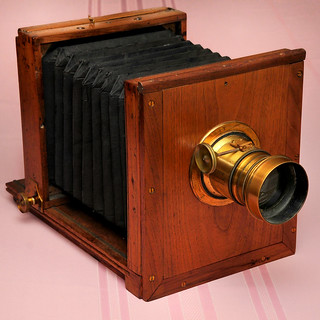Difference between revisions of "Wet-collodion"
(in progress) |
Hanskerensky (talk | contribs) m (→Links: Repaired Link URL) |
||
| (29 intermediate revisions by 6 users not shown) | |||
| Line 1: | Line 1: | ||
| − | {{ | + | {|class="floatright plainlinks" style="margin:0px 0px 20px 15px;" |
| − | '''Wet-Collodion''' is | + | | |
| + | {{Flickr_image | ||
| + | |image_source= https://www.flickr.com/photos/29504544@N08/7080107749/in/pool-camerawiki/ | ||
| + | |image= https://live.staticflickr.com/5322/7080107749_86fc3cafa3.jpg | ||
| + | |image_text= European Collodium Weekend Eindhoven 2012 | ||
| + | |image_by= Hans Kerensky | ||
| + | |image_rights= with permission | ||
| + | }} | ||
| + | |- | ||
| + | | | ||
| + | {{Flickr_image | ||
| + | |image_source= http://www.flickr.com/photos/romanart/4702872976/in/pool-camerawiki | ||
| + | |image= http://farm5.static.flickr.com/4044/4702872976_1bba53be55_n.jpg | ||
| + | |image_text= Wet-plate camera by J.J. Pyne of Manchester, with brass lens<br/>made by [[Charles Louis Chevalier]] | ||
| + | |image_by= Roman Art | ||
| + | |image_rights= with permission | ||
| + | }} | ||
| + | |- | ||
| + | |} | ||
| + | The '''Wet-Collodion''' (or wet-plate collodion) process is an early negative-positive [[:Category:Photographic processes|photographic process]]. It was invented in 1850, and published in 1851 by [[Frederick Scott Archer]], although a Frenchman, Gustave Le Gray may have discovered the process independently at around the same time. | ||
| − | The process was | + | The process uses potassium iodide dissolved with ''collodion'' - a solution of gun-cotton (nitro-cellulose) in ether. Gun-cotton is made by treating cotton wool (almost pure cellulose) with nitric acid. Nitro-cellulose was later used as a flexible base material for film; in the wet collodion process however, it does the same job that gelatine does in modern film; it contains the light-sensitive material, in a layer permeable to chemical solutions. In a photography manual, John Towler (1866) describes two methods of preparing gun-cotton (or ''pyroxyline''), but recommends buying the commercially-made product.<ref name=Towler>Towler, John (1866) ''The Negative and the Print; or the Photographer's Guide in the Gallery and in the Field''. Joseph H. Ladd, New York. Available in [http://www.archive.org/details/negativeprintorp00towluoft various formats] including [http://www.archive.org/download/negativeprintorp00towluoft/negativeprintorp00towluoft.pdf PDF] at the [http://www.archive.org/ Internet Archive]; supplied by [http://www.ryerson.ca/library/ Ryerson University Library], Toronto.</ref> |
| + | |||
| + | The potassium iodide/collodion solution is poured onto glass plates, after which the ether evaporates. Before the ether completely evaporates, the plates are sensitized in a bath of silver nitrate solution. Crystals of silver iodide form within the collodion film; these are the light-sensitive element of the emulsion. The plate has to be loaded into a dark slide and exposed while still wet, so the plate preparation has to be done immediately before use (once dry, the collodion is much less permeable to the developing solution<ref name=NMM></ref>). This means that outside the studio, wet-plate photographers had to carry a small dark-tent with a supply of plates, sensitization bath and bottles of the solutions.<ref>A [http://www.archive.org/details/beginnersguideto00londuoft Beginner's Guide to Photography] (about 1891) by 'A Fellow of the Chemical Society' Published by [[Perken Son and Rayment]], available in various formats [https://ia801605.us.archive.org/8/items/beginnersguideto00londuoft/beginnersguideto00londuoft.pdf including PDF] at [http://www.archive.org The Internet Archive], shows (on page 126) such a tent; this one is a ''Ruby'' tent, made of orange and red fabric so that the user can handle non-panchromatic plates safely under the light that penetrates.</ref> | ||
| + | |||
| + | However, the process was popular, in part because the plates were considerably more sensitive than other existing media such as [[Calotype]], allowing shorter exposure times, which in particular made portrait photography more convenient.<ref name=NMM>[https://web.archive.org/web/20140703192801/http://www.nationalmediamuseum.org.uk/ National Media Museum] Information Sheet [https://web.archive.org/web/20140917034107/http://www.nationalmediamuseum.org.uk/~/media/Files/NMeM/PDF/Collections/Photography/PhotographsOnGlass.ashx ''Photographs on Glass''] (archived).</ref> | ||
| + | |||
| + | With photographers preparing the materials themselves, it is not surprising that many variations of the process were developed. Towler<ref name=Towler></ref> gives four formulae for emulsions containing different mixtures of halide salts; ammonium or cadmium iodide and/or bromide, in different proportions for landscape or portrait use. One formula includes magnesium chloride (the use of this emulsion is not explained, beyond that it does not contain bromide). | ||
| + | |||
| + | Some of the silver nitrate sensitizing solution would drain from the plate in the camera: Edward Estabrooke (1903) in a manual for the ferrotype process, recommends treating new wooden plate holders by immersing them in boiling oil, or treating them with melted paraffin wax, to protect the wood from the solution, and applying shellac varnish, weekly if the holders are to be used continuously.<ref name=Estabrooke>Estabrooke, E.M. (1903) ''The Ferrotype and How to Make it'' Anthony and Scovill Co., New York, 12th edition 1903. p45. Available in [http://www.archive.org/details/ferrotypehowtoma00esta various formats] including [http://www.archive.org/download/ferrotypehowtoma00esta/ferrotypehowtoma00esta.pdf PDF] at the [http://www.archive.org/ Internet Archive]; supplied by the [http://www.nypl.org/ New York Public Library].</ref> | ||
| + | |||
| + | The collodion process was used in other forms beside the glass negative plate: | ||
| + | * [[Ambrotype]]s are direct ''positive'' images made by the wet collodion method on glass plates, using the reflective property of the developed silver image. | ||
| + | * [[Ferrotype]]s (also called tintypes or melanotypes) are direct positive images made in the same way, but on black enamelled iron plates, which were cheaper, lighter and more robust than glass plates. | ||
| + | |||
| + | |||
| + | ==Notes== | ||
| + | <references /> | ||
| + | |||
| + | |||
| + | ==Links== | ||
| + | * [https://collodion.com/default.asp Wet Plate Collodion Forum] | ||
| + | * [http://en.wikipedia.org/wiki/Collodion_process ''Collodion Process'' at Wikipedia] | ||
| + | * [http://unblinkingeye.com/Articles/WPC/wpc.html ''Getting Started in Wetplate Collodion Photography''] by Joseph Smigiel on [http://unblinkingeye.com/ Unblinking Eye]. | ||
| + | * [http://www.mhs.ox.ac.uk/cameras/item8.htm Lewis Carroll's wet-collodion outfit] and a [http://www.mhs.ox.ac.uk/cameras/index.htm?item7 portable sensitizing tank for collodion plates] in the catalogue of an exhibition ''Cameras: the Technology of Photographic Imaging'' at [http://www.mhs.ox.ac.uk/ Museum of the History of Science, Oxford] 20 May - 13 September 1997. | ||
| + | * Wet-plate equipment at [http://www.earlyphotography.co.uk/index.html Early Photography]: | ||
| + | ** [http://www.earlyphotography.co.uk/site/entry_C281.html Horne & Thornthwaite sliding-box camera, 1857] | ||
| + | ** [http://www.earlyphotography.co.uk/site/entry_C382.html Dallmeyer stereo wet-plate camera, 1863] | ||
| + | ** [http://www.earlyphotography.co.uk/site/entry_C374.html Dallmeyer bellows camera for wet ''and'' dry plates, 1882] | ||
| + | ** [http://www.earlyphotography.co.uk/site/entry_C80.html G.J. Bourdin Dubroni No. 1, c.1867]; wet plates were developed, fixed and washed ''in'' this camera! | ||
| + | ** [http://www.earlyphotography.co.uk/site/entry_H7.html Dark tent] for wet plate development. | ||
| + | * Video at [http://www.youtube.com/ YouTube]: [https://www.youtube.com/watch?v=uuOPxAEu9IE The Collodion Process] by [http://www.youtube.com/user/GeorgeEastmanHouse/videos George Eastman House] | ||
[[Category: Photographic processes]] | [[Category: Photographic processes]] | ||
| − | + | [[Category: Image by National Maritime Museum]] | |
| − | |||
Latest revision as of 05:43, 2 December 2023
| ||
|
The Wet-Collodion (or wet-plate collodion) process is an early negative-positive photographic process. It was invented in 1850, and published in 1851 by Frederick Scott Archer, although a Frenchman, Gustave Le Gray may have discovered the process independently at around the same time.
The process uses potassium iodide dissolved with collodion - a solution of gun-cotton (nitro-cellulose) in ether. Gun-cotton is made by treating cotton wool (almost pure cellulose) with nitric acid. Nitro-cellulose was later used as a flexible base material for film; in the wet collodion process however, it does the same job that gelatine does in modern film; it contains the light-sensitive material, in a layer permeable to chemical solutions. In a photography manual, John Towler (1866) describes two methods of preparing gun-cotton (or pyroxyline), but recommends buying the commercially-made product.[1]
The potassium iodide/collodion solution is poured onto glass plates, after which the ether evaporates. Before the ether completely evaporates, the plates are sensitized in a bath of silver nitrate solution. Crystals of silver iodide form within the collodion film; these are the light-sensitive element of the emulsion. The plate has to be loaded into a dark slide and exposed while still wet, so the plate preparation has to be done immediately before use (once dry, the collodion is much less permeable to the developing solution[2]). This means that outside the studio, wet-plate photographers had to carry a small dark-tent with a supply of plates, sensitization bath and bottles of the solutions.[3]
However, the process was popular, in part because the plates were considerably more sensitive than other existing media such as Calotype, allowing shorter exposure times, which in particular made portrait photography more convenient.[2]
With photographers preparing the materials themselves, it is not surprising that many variations of the process were developed. Towler[1] gives four formulae for emulsions containing different mixtures of halide salts; ammonium or cadmium iodide and/or bromide, in different proportions for landscape or portrait use. One formula includes magnesium chloride (the use of this emulsion is not explained, beyond that it does not contain bromide).
Some of the silver nitrate sensitizing solution would drain from the plate in the camera: Edward Estabrooke (1903) in a manual for the ferrotype process, recommends treating new wooden plate holders by immersing them in boiling oil, or treating them with melted paraffin wax, to protect the wood from the solution, and applying shellac varnish, weekly if the holders are to be used continuously.[4]
The collodion process was used in other forms beside the glass negative plate:
- Ambrotypes are direct positive images made by the wet collodion method on glass plates, using the reflective property of the developed silver image.
- Ferrotypes (also called tintypes or melanotypes) are direct positive images made in the same way, but on black enamelled iron plates, which were cheaper, lighter and more robust than glass plates.
Notes
- ↑ 1.0 1.1 Towler, John (1866) The Negative and the Print; or the Photographer's Guide in the Gallery and in the Field. Joseph H. Ladd, New York. Available in various formats including PDF at the Internet Archive; supplied by Ryerson University Library, Toronto.
- ↑ 2.0 2.1 National Media Museum Information Sheet Photographs on Glass (archived).
- ↑ A Beginner's Guide to Photography (about 1891) by 'A Fellow of the Chemical Society' Published by Perken Son and Rayment, available in various formats including PDF at The Internet Archive, shows (on page 126) such a tent; this one is a Ruby tent, made of orange and red fabric so that the user can handle non-panchromatic plates safely under the light that penetrates.
- ↑ Estabrooke, E.M. (1903) The Ferrotype and How to Make it Anthony and Scovill Co., New York, 12th edition 1903. p45. Available in various formats including PDF at the Internet Archive; supplied by the New York Public Library.
Links
- Wet Plate Collodion Forum
- Collodion Process at Wikipedia
- Getting Started in Wetplate Collodion Photography by Joseph Smigiel on Unblinking Eye.
- Lewis Carroll's wet-collodion outfit and a portable sensitizing tank for collodion plates in the catalogue of an exhibition Cameras: the Technology of Photographic Imaging at Museum of the History of Science, Oxford 20 May - 13 September 1997.
- Wet-plate equipment at Early Photography:
- Horne & Thornthwaite sliding-box camera, 1857
- Dallmeyer stereo wet-plate camera, 1863
- Dallmeyer bellows camera for wet and dry plates, 1882
- G.J. Bourdin Dubroni No. 1, c.1867; wet plates were developed, fixed and washed in this camera!
- Dark tent for wet plate development.
- Video at YouTube: The Collodion Process by George Eastman House

